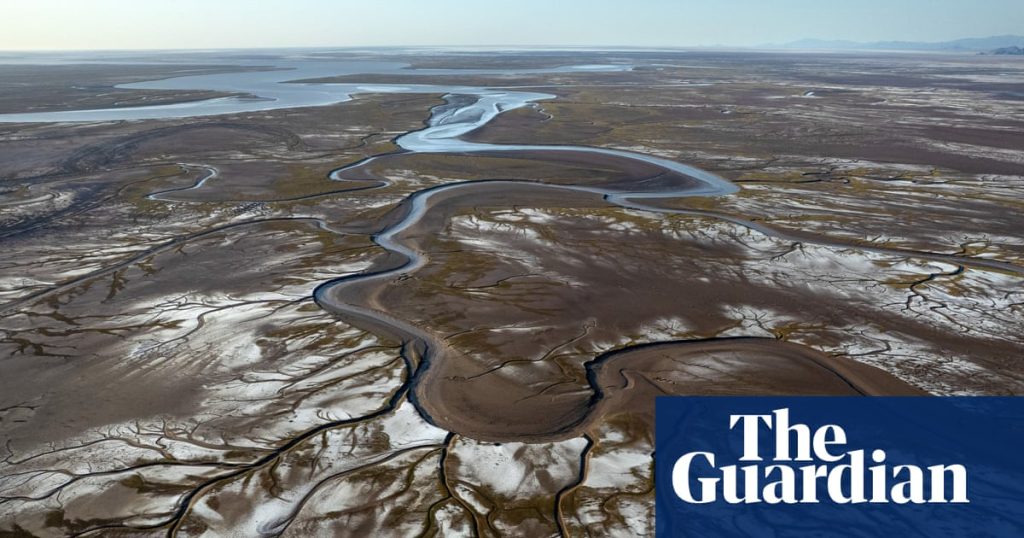State negotiators embroiled in an impasse over how to manage the imperiled Colorado River were unable to agree on a plan before a federally set deadline on Tuesday, thrusting deliberations deeper into uncertain territory.
Stakeholders have spent months working to iron out contentious disagreements over how to distribute water from this sprawling basin – which supplies roughly 40 million people in seven states, 5.5m acres of farmland, dozens of tribes and parts of Mexico – as the resources grow increasingly scarce.
Long-term overuse and the rising toll from the climate crisis have served as a one-two punch that’s left the system in crisis.
Enough progress was made to warrant an extension, according to a joint statement issued by federal officials and representatives from the seven western states. But the discussions – and the deadline set for them – were set to an urgent timeline; current guidelines are expiring and a new finalized agreement must be put in place by October 2026, the start of the 2027 water year.
Time is running short to schedule several steps required to implement a plan, including public engagement and environmental analysis. Final details are due by February 2026.
“There are external factors that make this deadline real,” said Anne Castle, a water policy expert and a former chair of the Upper Colorado River Commission. “It’s unfortunate for all the water users in the Colorado River Basin that the states have been unable to come to an agreement on the next set of operating guidelines for the river.”
It’s unclear whether a new deadline has been set or how discussions will proceed. If negotiators are unable to create a plan, it’s still possible the federal government will step in, an outcome experts say could lead to litigation and more delays.
“The urgency for the seven Colorado River Basin states to reach a consensus agreement has never been clearer,” said Scott Cameron, the Department of the Interior’s acting assistant secretary for water and science, in a statement issued in August, along with a 24-month federal study that highlighted the dire impacts left by unprecedented drought in the basin.
“The health of the Colorado River system and the livelihoods that depend on it are relying on our ability to collaborate effectively and craft forward-thinking solutions that prioritize conservation, efficiency, and resilience,” he added.
But since they were tasked by federal officials in June to come up with a broad plan by 11 November, the closed-door discussions have been wrought with tension. Key questions, including specifics on the terms of a new agreement, how to measure shortages and conservation efforts, and who would bear the brunt of the badly needed cuts, have stymied consensus. Upper basin states – Colorado, Utah, Wyoming, and New Mexico, were pinned against the lower basin – California, Arizona, and Nevada.
“They had to reach an agreement that almost by definition is going to result in hardship to some of those water users,” said Castle. “That was the crux of the problem.”
Water from the mighty 1,450-mile river that snakes through the western US has been used to raise thriving cities like Los Angeles, Phoenix and Las Vegas and turn arid desert landscapes into lush breadbaskets. Its flows grow thirsty crops, like alfalfa and hay, used as feed for livestock. Roughly 80% of the supply goes to agriculture.
Overuse has totalled roughly 3.5m acre-ft a year – an amount equal to more than a quarter of the river’s annual average flow. One acre-foot, a unit of measurement denoting the amount that can cover a football field in one foot depth and is used for large quantities of water, equals roughly 326,000 gallons – enough to supply roughly three families for a year.
The ecosystems on the banks of the river have paid a heavy price. Fourteen native fish species are endangered or threatened. The once-lush wetlands in Mexico’s river delta have been dry for decades. California’s Salton Sea, a saline lake fed by the river, has turned toxic by the drought.
Meanwhile, spiking temperatures have baked moisture out of the basin. Shrinking mountain snowpacks offer less melt year after year as increased evaporation takes a greater share. The river has lost more than 10tn gallons of water in the last two decades alone. The two largest reservoirs are projected to reach historic lows in the next two years.
“There’s not enough water to supply all the uses we have been making of it.” Castle said. She added that even without an agreement, users will still be forced to take cuts. “We know water use has to be reduced – and reduced substantially. The issue is how.”
If it comes down to letting the Bureau of Reclamation decide – or worse, a judge, should the issues be litigated – Castle said the outcome will be worse for everybody. A compromise – one that comes quickly – is paramount.
“They all have to hold hands to jump in the pool together.”

